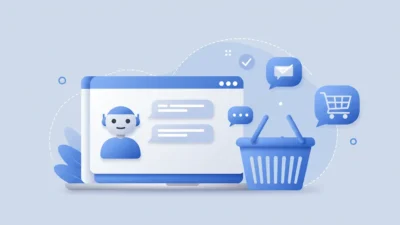Ready to build your own AI chatbot but don’t know where to start? This hands-on LangChain tutorial takes you from zero to a functional chatbot, with clear code examples and practical tips for beginners. We’ll cover everything from setting up your environment to deploying your chatbot using Streamlit, with a special focus on leveraging the incredible speed of Groq for your Large Language Models. This comprehensive guide is perfect for anyone wanting to leverage the power of LangChain for chatbot development.
Why LangChain for Chatbot Development?
LangChain is a powerful framework that simplifies the process of building sophisticated and interactive AI chatbots. Unlike working directly with LLMs, LangChain provides a structured way to manage prompts, chain multiple operations together, and integrate with external data sources. This makes it significantly easier to develop complex chatbot functionalities, such as maintaining conversation history and accessing external knowledge bases. Key benefits include:
- Modular Design: Easily swap different LLMs and components.
- Chain Management: Streamline complex interactions by chaining together different functions.
- Memory Management: Implement conversational memory for context-aware responses.
- Agent Capabilities: Enable your chatbot to interact with external tools and APIs.
- Simplified Development: Reduces the boilerplate code required for chatbot development.
Setting Up Your LangChain Environment
Before we begin building our chatbot, we need to set up our development environment. This involves installing LangChain and its dependencies, and choosing a suitable Large Language Model (LLM).
Installing LangChain and Dependencies
First, ensure you have Python installed. You can download it from python.org. Then, open your terminal or command prompt and create a new virtual environment:
python3 -m venv .venv
source .venv/bin/activate # On Windows: .venv\Scripts\activateNow, install LangChain and its required dependencies using pip:
pip install langchain groqWe’ll be using Groq’s API in this tutorial for its remarkable speed and cost-effectiveness. Remember to set your GROQ_API_KEY as an environment variable (e.g., export GROQ_API_KEY=”YOUR_API_KEY”). You can generate your API key and explore available models at the Groq console.
Choosing Your LLM (e.g., Groq API)
For this tutorial, we’ll use Groq’s gemma2-9b-it model via their API, which offers high-speed and competitive pricing for LLM inference. LangChain supports a wide variety of LLMs, and Groq is an excellent choice for fast and efficient development, particularly for real-time applications. You can find more information on integrating Groq in the official LangChain documentation, as well as details on other LLMs at the official LangChain documentation.
Core Concepts: Chains, Prompts, and Agents
Understanding the core concepts of LangChain is crucial for effective chatbot development.
- LLMs (Large Language Models): The brains of your chatbot, responsible for generating text.
- Prompts: The instructions you give to the LLM guiding its response. Well-crafted prompts are essential for getting the desired output. Remember to check out our guide on LangChain prompt templates.
- Chains: Sequences of calls to LLMs or other utilities, allowing for complex interactions. Chains combine prompts and LLMs to create more elaborate functionality.
- Agents: Dynamic components that use LLMs to decide which actions to take and in what order, often interacting with external tools or APIs.
Step-by-Step: Building a Simple LangChain Chatbot
Let’s build a basic chatbot that responds to user input.
Defining Your Prompt Template
We’ll start by defining a prompt template that will guide the LLM’s response. This template will include the user’s input and any relevant context.
from langchain.prompts import PromptTemplate
template = """You are a helpful assistant. The user asked: {question}"""
prompt = PromptTemplate(template=template, input_variables=["question"])Creating a Simple Chain
Next, we’ll create a simple chain that uses the prompt template and a Groq LLM to generate a response.
from langchain_community.llms import Groq
from langchain.chains import LLMChain
# Initialize the Groq LLM.
# 'temperature=0' makes responses more deterministic.
# 'model_name="gemma2-9b-it-32768"' specifies the Groq model to use.
llm = Groq(temperature=0, model_name="gemma2-9b-it-32768")
chain = LLMChain(llm=llm, prompt=prompt)Adding Memory to Your Chatbot
For more engaging conversations, add memory to your chatbot. This allows it to remember previous interactions and maintain context. We’ll use ConversationBufferMemory for this example:
from langchain.memory import ConversationBufferMemory
from langchain.chains import ConversationChain
memory = ConversationBufferMemory()
# For conversational memory, it's often better to use ConversationChain directly
# as it's designed to handle chat history and integrate with a prompt template.
chain = ConversationChain(llm=llm, memory=memory, prompt=prompt)Deploying Your LangChain Chatbot with Streamlit
Streamlit is a fantastic tool for quickly deploying your chatbot. First, install Streamlit:
pip install streamlitThen, create a Streamlit app (e.g., app.py):
import streamlit as st
from langchain.prompts import PromptTemplate
from langchain_community.llms import Groq
from langchain.chains import ConversationChain
from langchain.memory import ConversationBufferMemory
import os
# Ensure your Groq API key is set as an environment variable
# os.environ["GROQ_API_KEY"] = "YOUR_API_KEY" # Uncomment and replace if you prefer hardcoding (not recommended for production)
# Initialize the Groq LLM
llm = Groq(temperature=0, model_name="gemma2-9b-it-32768")
# Initialize memory for the chatbot
if "memory" not in st.session_state:
st.session_state.memory = ConversationBufferMemory()
# Define your prompt template
template = """The following is a friendly conversation between a human and an AI. The AI is talkative and provides lots of specific details from its context.
Current conversation:
{history}
Human: {input}
AI:"""
prompt = PromptTemplate(template=template, input_variables=["history", "input"])
# Create the conversational chain
conversation = ConversationChain(
llm=llm,
memory=st.session_state.memory,
prompt=prompt
)
st.title("My LangChain Chatbot (Powered by Groq)")
# Display chat history
for message in st.session_state.memory.buffer.split("\n"):
if message.strip(): # Avoid empty lines
if message.startswith("Human:"):
st.chat_message("user").write(message.replace("Human:", "").strip())
elif message.startswith("AI:"):
st.chat_message("assistant").write(message.replace("AI:", "").strip())
# Get user input
user_input = st.chat_input("Ask me anything:")
if user_input:
# Append user's message to the display
st.chat_message("user").write(user_input)
# Get response from the chatbot
with st.spinner("Thinking..."):
response = conversation.predict(input=user_input)
st.chat_message("assistant").write(response)Run the app using streamlit run app.py. This will launch a web interface for your chatbot.
Troubleshooting Common LangChain Issues
- API Key Errors: Double-check your API key is correctly set as an environment variable (GROQ_API_KEY).
- Rate Limits: Be mindful of API rate limits to avoid exceeding your allowance. Groq offers generous free tier limits, but it’s good to be aware.
- Prompt Engineering: Experiment with different prompt templates to improve the quality and relevance of responses.
- Memory Issues: If your chatbot forgets previous interactions, adjust the memory settings or consider different memory types offered by LangChain.
Conclusion: Your First AI Chatbot is Live!
Congratulations! You’ve successfully built and deployed your first AI chatbot using LangChain, powered by the impressive speed of Groq. This tutorial provided a foundational understanding of LangChain’s capabilities. Remember to explore the extensive LangChain documentation to unlock even more advanced features and build increasingly sophisticated chatbots. From here, you can explore integrating external data sources, adding more complex chains, and implementing advanced agent capabilities to create truly powerful and interactive AI experiences. Remember to check out our guide on LangChain prompt templates.
FAQs About LangChain Chatbot
- What is LangChain and why is it used for chatbots?
LangChain is an open-source framework designed to simplify the development of applications powered by large language models (LLMs). It’s used for chatbot development because it provides tools for managing prompts, chaining multiple operations, integrating with external data sources, and implementing sophisticated memory mechanisms, all of which are crucial for creating engaging and functional chatbots.
- Do I need extensive coding experience for this LangChain tutorial?
No, this tutorial is designed for beginners. While some basic Python knowledge is helpful, the code examples are straightforward and well-commented. The focus is on understanding the core concepts and applying them practically.
- What are the key components of a LangChain chatbot?
The key components include an LLM (like Groq’s gemma2-9b-it), a prompt template to guide the LLM, chains to sequence operations, and optionally, memory to maintain conversational context and agents to interact with external tools. Remember to check out our guide on LangChain prompt templates.






[…] it for different topics or even post to Twitter instead. Want more guides like this? Check out our LangChain Chatbot Tutorial and Secret Prompt Engineering […]